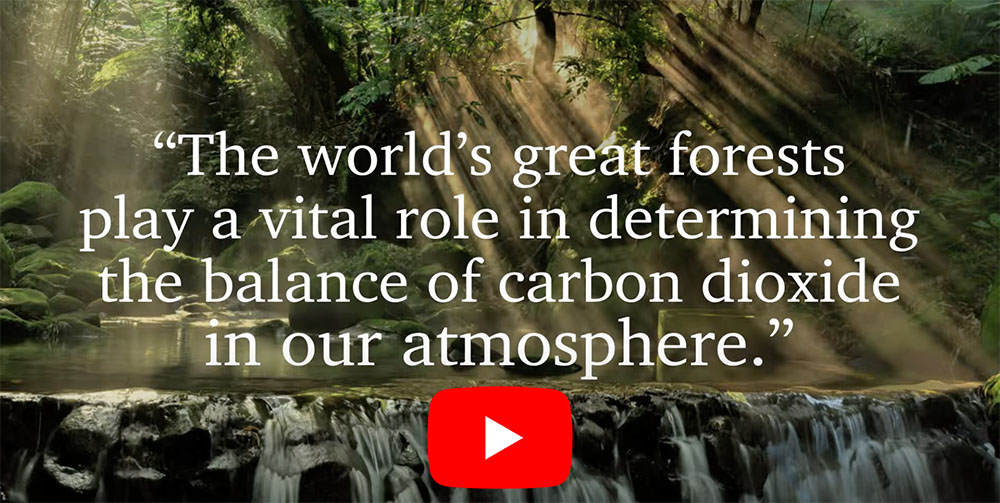Presentation from Griffith University to the Global Landscapes Forum, Bern, 2019.
Transcript:
The world’s primary forests remain under significant threat from damaging government policies and economic activities that promote deforestation.
Logging for timber and clearing to make way for mining, cropping, grazing and urban development continue to make inroads into the remaining large areas of intact forest.
This has well-documented impacts on biodiversity and greenhouse gas emissions, but it also impinges on the lives of the people who live in and depend on these forests for the food, water, materials and livelihoods.
Globally, around 600 million people call the forests home. Many of these people are in tropical regions.
A further 800 million depend - to an extent - on forests to provide for their livelihoods.
As our economies find more ways to get more carbon into the atmosphere at an ever-faster rate, primary forests become even more important as stalwarts against rising emissions.
We cannot solve the climate crisis without solving the deforestation crisis.
Formally protected forested areas are necessary, but insufficient, for maintaining large areas of intact forest. Protected area forest is still being lost. Preservation of tropical primary forests cannot only happen behind the fences of national parks, protected from incursion by timber getters, graziers and mining companies through regulations and fines.
People live amongst these forests, earning their livelihoods from the ecosystem goods and services these forests provide. The forests provide sources of subsistence food and materials and can supply marketable products they might trade.
The forests are also the basis for their cultures and cosmologies. Their relationship to country is intimately tied to the cycles of nature, their patterns of natural resource harvesting, and to their connections between past, current and future generations.
On a different scale, these forests are valued by the global community as one of the key global stocks of sequestered carbon. 25% of all terrestrial carbon is stored in forests. The importance of – specifically – intact primary forests as carbon stocks is only now being fully appreciated. Together, these locally- regionally- and globally-experienced values represent a basket of benefits.
The Economics of the Environment and Biodiversity project, or TEEB, encourages policymakers to recognise, demonstrate and then find ways to capture the benefits provided by ecosystem goods and services, which are often invisible to formal traded markets.
Environmental economics plays a role in demonstrating - or quantifying (often in dollar terms) many of these values.
Economics can also play a role in designing schemes that can help forest communities begin to capture the benefits provided by conservation efforts. The full spectrum of these ecosystem service values can be assessed through the concept of Total Economic Value, or TEV.
Using the framework of TEV ensures all aspects of ecosystem service value - tangible and intangible, extractive and non-extractive - are accounted for.
- Direct use values are those experienced first-hand and the output is consumed directly.mDirect value is gain from use of rival, extractive goods, such as the timber or wild animals, or the use of non-rival, or non-extractive services, such as tourism. Many direct use values can be valued using traditional economic measures.
- Indirect use values start to get more difficult to consistently measure. These are goods and services that people experience second-hand, as an outcome of ecological functions that would continue regardless of human activation. For example, we benefit from a more stable climate, thanks to the forest preservation efforts of forest communities; floods are mitigated by the actions of upstream land managers in maintaining vegetation cover.
- Non-use values variously include bequest, vicarious and existence values – those values where our selves receive value from our knowledge that other people, or future generations experience value. Or from our own intrinsic, altruistic values we experience from nature.
Environmental economics techniques can tease-out these non-use values.
The fundamental problem of environmental economics stems from the activities that provide value for one person are often in conflict with another.
Trade-offs are needed, but often we lack the institutions to enable that trade-off. Trade- offs are not only needed between different levels of environmental service delivery, but also often between different communities. One group of people may be custodians of a habitat that provide ecosystem services to another.
For example, forgoing income from the sale of timber, or refraining from clearing forest to make way for palm oil, is a cost to those undertaking the conservation, yet they have no mechanism to receive compensation. And the beneficiaries often have no requirement, to make good.
Understanding where the value proposition lies is a key part of understanding how a forest conservation economy can be financed to both protect forests and improve human well-being. Working out who benefits from conservation actions, and how and when they benefit is a starting point.
Conversely, understanding whom forgoes opportunities or income – who pays the costs - is the obvious corollary. For example, carbon sequestration services are - in the main - valued by the global north for whom mitigating emissions is the key motivating factor.
Yet, the carbon is stored in forests managed by communities a long way away and for whom the preservation of these forests for carbon sequestration is the least of their concerns.
Watershed services – such as the retention of forest cover to provide drinking water, or to reduce sediment flowing into coral reef lagoons, is a further example where one party is providing a service – clean water and a healthy reef – for which it may not receive compensation from another party – a hotel beach complex, for example, that is benefitting from these services.
Exchanges of economic value such as these, need mechanisms that can enable that exchange. One such concept is payments for ecosystem services, or PES. PES is an exchanges of value for the retention of functioning ecosystems, often in the form of cash or in-kind payments in exchange for the preservation of habitats, often through a broker or an intermediary.
Often this value exchange is international in nature – a transfer from the global north to the global south. However, such distances, both geographic and cultural, clearly cause difficulties for governance – In ensuring both parties upholds their commitments.
PES schemes are characterized as being voluntary, fair, based on conditionality and being pro-poor. They can come in a number of flavours, depending on the emphasis given to each of these four attributes. Fully commoditized schemes are those that emphasize conditionality on the outcomes achieved – the amount of carbon stored in a reforestation project, for example.
Other types of schemes emphasize behavioral change, such as refraining from earning income from deforestation, and less on outcomes. Often poverty reduction outcomes are included.
Thirdly, there are hybrid versions that emphasize co-investment in landscape stewardship and local resource management, where the buyers and sellers of services are less well-defined.
PES schemes from all three flavours will continue to play a role in tropical forest preservation.
The micro-economics teams from Griffith University in Brisbane and Woods Hole Research Centre in the United States have been working with their inter-disciplinary colleagues on the Primary Forests project on three case studies, in Melanesia, Brazil and the Democratic Republic of Congo.
Each of the case studies presents different challenges for understanding how the local economic factors and property rights arrangements impact on livelihoods from forest economies and PES schemes can be designed.
To help start answer some these questions we are carrying out field studies in two social science and economics methods: discreet choice experiments and Q-method.
We are also undertaking a systematic literature review to document the global state of knowledge on the economic value of the ecosystem services provided by primary forests.
Q method (so called because it is an inversion of R-based survey methods) is a process of determining dominant discourses amongst groups of people. We look for commonalities in the way people look at the world.
Q uses strategic sampling of respondents. We ask them to rank issues – most commonly on written cards – in a quasi-normal distribution, in answer to a ‘primer question’.
The card set is constructed from a range of informal elicitation methods, including focus groups and interviews, where people are encouraged to discuss what issues within a particular domain are important to them. As such, it can uncover non-hypothesized issues.
Once all the sampling is completed, the data is subject to statistical analysis that looks for correlations between these sorts. The correlated sorts are considered dominant factors, or discourses.
The last step is to describe these dominant factors in words. These descriptions can provide insight into community attitudes towards the domain in question, can uncover consensus items and can help refine the language with which to engage the community.
We have performed Q on the island of Tanna, in the Republic of Vanuatu in Melanesia- seeking to reveal dominant attitudes towards natural resource management of the forests and the reefs in the context of environmental and social and economic change. We used illustrators to ensure the cards and the process was well-understood and engaging.
From the perspective of forest conservation, our initial findings from Tanna are encouraging. The strongest correlation, by a significant degree, suggests there’s a widely-shared discourse of environmental stewardship, based on strong and intimate connections between the community, the landscape and the resources it provides.
This is bound-up with traditional practices, and community decision making structures into the concept kastom. In the Democratic Republic of Congo, we are using a choice experiment to estimate community preferences for the ideal value of a PES scheme.
Choice experiments attempt to reveal valuations of non-market goods and services, such as the ecosystem services provided by forests – where there are no markets, or surrogate markets through people can express the preferences.
Respondents are asked to state their preferences through a series of choice cards -each containing a hypothetical trade-off between alternative outcomes, described in terms of different combinations of levels of delivery of a range of environmental attributes
In addition, a monetary value (or “price tag”) is normally included as one attribute – used to reveal compensation rates – willingness to accept -for loss of service, or payment rates for greater environmental services.
When scaled-up these observations can provide aggregate values for ecosystem services.
In this instance the choice experiment can be used to determine what level a payment for ecosystem service scheme might need to be in order to secure a continuous change in behaviour in how forest resources are exploited.
In other words, how much would members of the community need to be compensated in order to reduce their impact on extractive activities in the forest. The experiment will also seek to determine peoples’ preferences for how a payment is administered and paid. Are there preferences for payment in cash, or in-kind in goods and services, such as household items or community assets, such as schools and medical centres?
Our findings will be able to help policy makers understand how PES schemes can be best designed to meet the local conditions and preferences. It can also reveal a price for purchasers of the environmental services.
Lastly, we are undertaking a systematic literature review, guided by the overarching question of “what is the value of ecosystem services provided by the world’s primary forests?”
Our review has three steps.
Firstly, we have identified the key literature through a broad-ranging search of four databases: SCOPUS, Web of Science, Science Direct and Google.
Next we went through a screening process, checking for relevance and ensuring the material selected is relevant to our research questions.
Finally, we undertake an eligibility and exclusion assessment, as part of our reading and documenting process.
In our search, we assessed more than 14,000 results. 1,762 of these were deemed relevant, of which 385 were duplicates. We are currently undertaking this third stage and beginning to analyze the data.
Our goal is to build a database of ecosystem service values for forests, equal in depth to the originally TEEB ecosystem services valuation database created by van der Ploeg and de Groot in 2010.
From our forests database, we can undertake meta-analyses of the data to ask more specific, or forest-type or location specific questions.
Protecting forests is as much about people and livelihoods as it is trees, biodiversity and ecosystem integrity. Understanding which ecosystem services are valued and by whom and by how much, can help stimulate the institutions required to enable the trade-offs in forest use and protection to be better reconciled.
Harnessing the ‘basket of benefits’ provided by forests can help demonstrate alternative ways forest can be valued, instead of simply as a function of their timber or as agricultural land.





